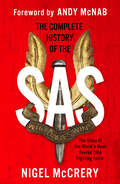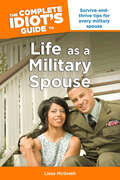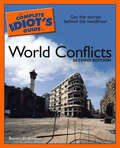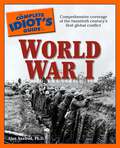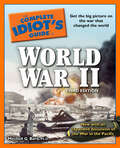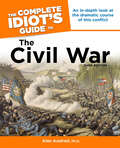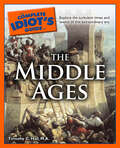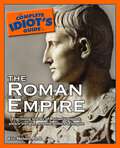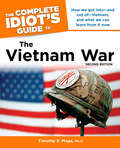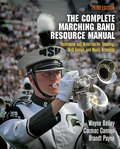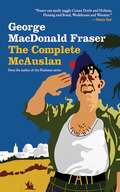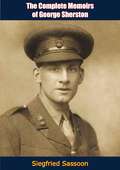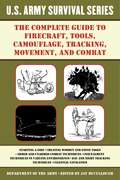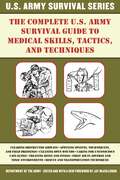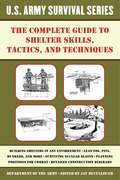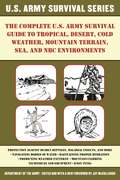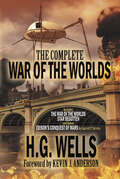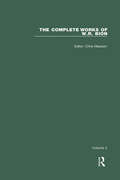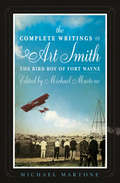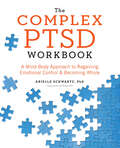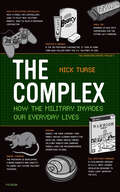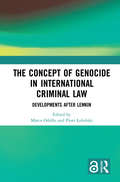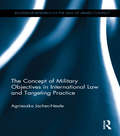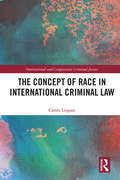- Table View
- List View
The Complete History of the SAS: The World's Most Feared Elite Fighting Force
by Nigel McCrerySpecializing in covert reconnaissance, counter-terrorism and hostage rescue, the SAS is one of the world's most famous, feared and respected elite fighting forces. This book tells the full, fascinating story of the regiment, from formation in the sand dunes of Africa during World War II to present action in the Middle East, and incorporates jungle, desert and urban warfare, counter-terrorism and an insider's view at the selection and training methods employed by this usually secretive unit.As well as an insightful foreword by Andy McNab – one of the most famous members of the SAS – this revised, updated edition includes completely new chapters, features and information, including Key Missions in WWII, The Battle of Mirbat, Iranian Embassy Siege, Kenyan Hotel Rescue and Victoria Cross Awards.
The Complete Idiot's Guide to Life as a Military Spouse
by Lissa McgrathFor better, for worse, for Uncle Sam . . . Today&’s military has changed dramatically—and spouses need to be prepared. Approximately half of our 1.4 million fighting men and women are married. And for a military spouse, information and support are not easy to find. Included here is:• How to enroll in the Child Development Homes program• What to do before a permanent change of station (PCS)• How to prepare for the deployment—and the return—of a spouse• Easy ways to calculate benefits, allowances, and special pays
The Complete Idiot's Guide to World Conflicts, 2E
by Steven D. StraussCold hard facts on the world&’s hot spots. Now readers can make sense of the daily headlines with an examination of the sides and issues of evolving conflicts. This updated edition provides coverage of all of the hot conflict spots in our world today, background and history, new and added coverage of the war on terror, and up-to-date coverage on the Middle East, including Iraq. • As Iraq continues to dominate the news, there is, unfortunately, no shortage of other trouble spots—this guide looks at conflicts around the globe. • An accurate reference source for high school and college students, and a great overview for people who want more in-depth understanding of daily events.
The Complete Idiot's Guide to World War I: Comprehensive Coverage of the Twentieth Century’s First Global Conflict
by Alan AxelrodYou&’re no idiot, of course. You know that World War I was &“the Great War,&” and you&’re familiar with its images: muddy trenches, poison gas, and a no–man&’s–land of craters and barbed wire.But when it comes to understanding its causes, why it dragged on for four years, and how it set the stage for World War II, you&’re lost behind enemy lines. Don&’t wave the white flag just yet! The Complete Idiot&’s Guide® to World War I gives you a comprehensive overview of the first global war, from the assassination of the Archduke Franz Ferdinand to the Treaty of Versailles. In this Complete Idiot&’s Guide®, you get: • Broad coverage of the secret treaties and en-tangling alliances that led to war • Comprehensive analysis of some of history&’s bloodiest battles, including the Somme, Tannenburg, Gallipoli, and Belleau Wood • Expert commentary on the development of weapons such as the tank, the dreadnought battleship, poison gas, and the German U-boat • Valuable insights into the war&’s influence on this century&’s political and cultural development
The Complete Idiot's Guide to World War II, 3rd Edition: Get the Big Picture on the War That Changed the World
by Mitchell G. BardThe Complete Idiots Guide® to World War II, Second Edition, will feature updated and expanded coverage of the fateful D-Day invasion, a critical timeline of major WW II events, and a WW II timeline highlighting the crucial and most important events of the war. It will include details about major battles on land, in the air, and on the sea-starting with Hitler's rise to power and his goal of European conquest, as well as Japan's bombing of Pearl Harbor and the decisive battles such as D-Day and the Battle of the Midway, which turned they tides of the war toward the Allies.
The Complete Idiot's Guide to the Civil War, 3rd Edition: An In-Depth Look at the Dramatic Course of This Conflict
by Alan AxelrodA battle ready guide to the deadliest war in American history Completely revised for the Sesquicentennial, The Complete Idiot's Guide® to the Civil War, Third Edition is a comprehensive overview of America's bloodiest war. From the first shots fired at Fort Sumter to Lee's surrender at Appomattox, this book embodies the latest scholarship, offering fascinating stories of the men and women who fought bravely and often died for a cause they believed in. The book features a clear chronology of major events, detailed explanations of key battles such as Gettysburg, Chattanooga, and Chancellorsville. Author Alan Axelrod offers intimate impressions and anecdotes from generals and soldiers alike, and strategies of war leaders such as Sherman, Lee, and Grant.
The Complete Idiot's Guide to the Middle Ages: Explore the Turbulent Times and Events of This Extraordinary Era
by Timothy C. HallShed some light on one of history&’s darkest periods. The Complete Idiot&’s Guide® to the Middle Ages gives readers the beginning, middle, and end of the era, starting with the fall of the Roman Empire in the year 550 and ending with the Renaissance in 1500—and covers some uncomfortable similarities between the so-called &“Dark Ages&” and today&’s &“modern world.&”- A fascinating, fact-filled book that delivers more than a thousand years of history in easy-to-understand chapters. - Many AP European History students are urged to read an overview of medieval Europe to aid in their understanding of modern Europe, and a number of high schools have adopted elective courses in medieval history. - Complete with a timeline, a who&’s who, and guides to further reading and the Middle Ages in film.
The Complete Idiot's Guide to the Roman Empire
by Eric NelsonYou&’re no idiot, of course. The battle scenes in Gladiator had you on the edge of your seat and wondering where you could find more information on the rise and fall of ancient Rome. But so far, your search has left you feeling like a blundering barbarian.Pick yourself up off the coliseum floor! Consult The Complete Idiot&’s Guide® to the Roman Empire—a fun–to–read introduction to the fascinating history, people, and culture of ancient Rome. In this Complete Idiot&’s Guide®, you get:• The history of the Roman Empire&’s rise and fall.• An idiot-proof introduction to the great epic literature of the Roman Republic.• A survey of the Romans in arts and popular culture.• Fascinating details of some of history&’s most nefarious emperors, including Nero, Caligula, and Commodus.
The Complete Idiot's Guide to the Vietnam War, 2nd Edition: How We Got into—and Out of—Vietnam, and What We Can Learn from It Now
by Timothy P. MagaA long ago war-still relevant today Misunderstanding remains, and a lot is still unknown, of the Vietnam War. The Complete Idiot's Guide® to the Vietnam War, Second Edition provides an updated and revised guide giving readers the facts. It assesses policies and the reasons for them, shedding light on the controversies regarding the Vietnam War, what has been called the most complicated armed conflict of the 20th century. It offers: • A big-picture look at the politics, public figures, and history of the war in Southeast Asia • Present-tense relevance of Vietnam to the current wars in which the United States, and the rest of the world, is involved • Clarification of details for those who lived through it and an explanation for younger generations
The Complete Marching Band Resource Manual: Techniques and Materials for Teaching, Drill Design, and Music Arranging
by Wayne Bailey Cormac Cannon Brandt PayneThe Complete Marching Band Resource Manual is the definitive guide to the intricate art of directing college and high school marching bands. Supplemented with musical arrangements, warm-up exercises, and over a hundred drill charts, this manual presents both the fundamentals and the advanced techniques that are essential for successful marching band leadership. The materials in this volume cover every stage of musical direction and instruction, from selecting music and choreographing movements to improving student memorization and endurance to the creation of striking visual configurations through uniform and auxiliary units.Now in its third edition, The Complete Marching Band Resource Manual has been thoroughly updated to reflect new standards for drill design, charting, and musical arrangement. Offering a fresh approach to the essentials of good marching band design, this comprehensive resource shows both veteran and novice band directors how to prepare students to perform seamless and sophisticated musical formations.
The Complete McAuslan: Stories From The Author Of The Beloved Flashman Series
by George Macdonald FraserGeorge MacDonald Fraser's hilarious stories of the most disastrous soldier in the British Army are collected together for the first time in one volume. Private McAuslan, J., the Dirtiest Soldier in the World (alias the Tartan Caliban, or the Highland Division's answer to the Pekin Man) first demonstrated his unfitness for service in The General Danced at Dawn. He continued his disorderly advance, losing, soiling or destroying his equipment, through the pages of McAuslan in the Rough. The final volume, The Sheikh and the Dustbin, pursues the career of the great incompetent as he shambles across North African and Scotland, swinging his right arm in time with his right leg and tripping over his untied laces. His admirers know him as court-martial defendant, ghost-catcher, star-crossed lover and golf caddie extraordinary. Whether map-reading his erratic way through the Sahara by night or confronting Arab rioters, McAuslan's talent for catastrophe is guaranteed. Now, the inimitable McAuslan stories are collected together in one glorious volume.
The Complete Memoirs of George Sherston (Faber Paper Covered Editions Ser.)
by Siegfried SassoonThe Memoirs of George Sherston brings together in one memorable volume the three widely-hailed “autobiographical novels” of the eminent English poet, Siegfried Sassoon. Set against the dark background of World War this extraordinary trilogy follows the author’s wartime fortunes and examines his emotional growth under the cruel pressures of hand-to-hand combat in the field.Perhaps the most striking qualities of Sassoon’s record are its honesty, its simplicity and its lack of pretentiousness and false heroics. It is, after all, a deeply personal account of a complete phase of a man’s life, spanning in continuous narrative form the period from the author’s childhood to the war’s end.The trilogy begins with Memoirs of a Fox-Hunting Man, a fond reminiscence of boyhood and adolescence set against the background of the author’s rural English home. Full of the scent of leather and the huntsman cries on a frosty autumn morning, the scene is set as the world moves slowly towards war.In the second volume, The Memoirs of an Infantry Office, the mood deepens. A classic among war books, it tells of the author’s steady disillusionment with the Army and of his ultimate rebellion against the cruel realities of war. Finally, in the last of the three, Sherston’s Progress, set in an asylum for shell-shocked officers, the author is able to accept these realities and to resolve his emotional turmoil.Through it all, there is always the presence of Sassoon—the fluid, sensitive prose, the fine perceptions of the poet—yet spoken here in the voice of the average man. With charm and humor and quiet understatement, he has managed to articulate the hidden feelings of any sensitive man who in the normal course of his life is suddenly exposed to the nightmare of war.
The Complete U.S. Army Survival Guide to Firecraft, Tools, Camouflage, Tracking, Movement, and Combat (US Army Survival)
by Army Jay McCulloughIn this vital guide, you’ll find important techniques of wielding firecrafts, constructing tools, creating camouflage, and tracking a prey’s movement. From step-by-step instructions on crafting a flint knife to tips on beating an opponent in close combat, The Complete U.S. Army Survival Guide to Firecraft, Tools, Camouflage, Tracking, and Movement has got you covered. Within these pages you’ll find: Guidelines on selecting the best site to start a fire The most effective moves to use against an opponent in any range of combat How-to chose an optimal location for cover in any terrain Instructions for tracking the movement of dozens of different animals And dozens more critical techniques!With dozens of photographs and illustrations demonstrating techniques and procedures first-hand, this guide is an essential read for every outdoorsman-from the novice weekend camper to the most seasoned survivalist. If you can’t find it within the pages of The Complete U.S. Army Survival Guide to Firecraft, Tools, Camouflage, Tracking, and Movement, then you don’t really need it.
The Complete U.S. Army Survival Guide to Foraging Skills, Tactics, and Techniques
by Jay McCulloughHere in this critical guide is all the important foraging techniques that you’ll need to know in order to survive in just about any situation. From selecting edible berries to trapping small game, The Complete U.S. Army Survival Guide to Foraging Skills, Tactics, and Techniques has got you covered. Within these pages, you’ll find: The proper procedure to construct a water distillery How to discern the difference between poisonous and deadly plants. A step-by-step guide to expertly skinning and cooking a squirrel. And hundreds more critical foraging techniques.With dozens of photographs and illustrations demonstrating these medical techniques and procedures first-hand, this guide is an essential read for every outdoorsman-from the novice weekend camper to the most seasoned survivalist. If you can’t find it in The Complete U.S. Army Survival Guide to Foraging Skills, Tactics, and Techniques, then you don’t really need it.
The Complete U.S. Army Survival Guide to Medical Skills, Tactics, and Techniques (US Army Survival)
by Jay McCulloughHere in this critical guide is all the important medical techniques that you’ll need to know in order to survive in just about any situation. From wrapping life-threatening head wounds to treating a poisonous spider bite, The Complete U.S. Army Survival Guide to Medical Skills, Tactics, and Techniques has got you covered. Within these pages, you’ll find: First-aid techniques for hundreds of different kinds of wounds. Medical procedures necessary for properly treating animal bites and stings. Proper procedures to follow when dealing with toxic environments. And thousands more essential medical tips.With dozens of photographs and illustrations demonstrating these medical techniques and procedures first-hand, this guide is an essential read for every outdoorsman-from the novice weekend camper to the most seasoned survivalist. If you can’t find it in The Complete U.S. Army Survival Guide to Medical Skills, Tactics, and Techniques, then you don’t really need it.
The Complete U.S. Army Survival Guide to Shelter Skills, Tactics, and Techniques (US Army Survival)
by Jay McCulloughHere in this critical guide is all the important safety techniques that you’ll need to know in order to survive in just about any condition. From designing a makeshift earthquake shelter to constructing a water well, The Complete U.S. Army Survival Guide to Shelter Skills, Tactics, and Techniques has got you covered. Within these pages, you’ll find information on the best way to: Choose the best building materials. Select the best ambushing positions in any situation. Construct an underground bunker. And hundreds of more techniques and skillsWith dozens of photographs and illustrations demonstrating these sheltering techniques and procedures first-hand, this guide is an essential read for every outdoorsman-from the novice weekend camper to the most seasoned survivalist. If you can’t find it in The Complete U.S. Army Survival Guide to Shelter Skills, Tactics, and Techniques, then you don’t really need it.
The Complete U.S. Army Survival Guide to Tropical, Desert, Cold Weather, Mountain Terrain, Sea, and NBC Environments
by Army Jay McCulloughWithin this indispensable guide, you’ll find every tip that you’ll ever need to thrive in any type of landscape, in any degree of climate. From managing the heat of the tropics to combatting the chill of the mountaintops, The Complete U.S. Army Survival Guide to Desert, Forest, Jungle, Plain, Mountain, and Urban Environment has got you covered. Within these pages you’ll discover such vital tips as: How-to treat hypothermia The correct method of righting a capsized craft Tips for minimizing the dire effects of chemical exposure And dozens more crucial survival tips!With dozens of photographs and illustrations demonstrating these procedures and techniques first-hand, this guide is an essential read for every outdoorsman-from the novice weekend camper to the most seasoned survivalist. If you can’t find it in The Complete U.S. Army Survival Guide to Desert, Forest, Jungle, Plain, Mountain, and Urban Environment then you don’t really need it.
The Complete War of the Worlds
by H. G. WellsFrom the father of science fiction, the nineteenth-century British classic novel of alien invasion, along with two sequels. Together in one volume for the first time—H. G. Wells&’s seminal science fiction classic The War of the Worlds, with the contemporaneous, unauthorized, but extremely popular sequel Edison&’'s Conquest of Mars, as well as Wells&’s own, much later conceptual sequel, Star Begotten. How often do you watch the sky at night? Ever see bright streaks of light exploding from the red planet? Get ready for adventurous reading as you embark on a journey to find out just how these alien invasions play out! In The War of the Worlds, how will woefully unprepared Earthlings respond to towering three-legged &“fighting machines&” armed with heat-rays and chemical weapons that far exceed the capabilities of the nineteenth-century English military? In Edison&’s Conquest of Mars, Earth's leaders fear that the Martians will return to invade once more. US President William McKinley, Queen Victoria, Kaiser Wilhelm II and Emperor Mutsuhito unite to plan an attack on Mars. Led by American inventor Thomas Edison, a group of scientists develop new technologies based on what earlier Martian visitors left behind. They design and build a fleet of space ships for the pre-emptive move. What will happen when the two opposing forces meet? The protagonist of Star Begotten, Joseph Davis, is an author of popular histories, who becomes suspicious that he and his family have been exposed to a Martian influence of another sort and are in the process of being changed. What might that influence be? Three classics of Martian invasion in one volume.
The Complete Works of W.R. Bion: Volume 3 (The Complete Works of W.R. Bion)
by W. R. BionThis volume, hand-written and contained in three hardbound notebooks, is Wilfred R. Bion's factual record of his war service in France in the Royal Tank Regiment between June 1917 and January 1919, written soon after he went up to The Queen's College, Oxford, after demobilized from the Army.
The Complete Writings of Art Smith, the Bird Boy of Fort Wayne, Edited by Michael Martone (American Reader Series #35)
by Michael MartoneThe Complete Writings of Art Smith, the Bird Boy of Fort Wayne, Edited by Michael Martone is a Midwestern mythology that celebrates facts, fiction, and the impermanence of art. Inspired by the real-life pioneer of early aviation who invented the art of skywriting, the brief stories in this collection by “editor” Michael Martone follow the adventures of Art Smith and his authorship in the sky. In the spirit of Kurt Vonnegut and Hayao Miyazaki, The Complete Writings of Art Smith, the Bird Boy of Fort Wayne, Edited by Michael Martone recreates the wonder of the early flying machines as it reimagines the unwritten stories we tell about the daredevils who flew them.
The Complex PTSD Workbook: A Mind-Body Approach to Regaining Emotional Control and Becoming Whole (Healing Complex PTSD)
by Arielle Schwartz PhDA mind-body workbook for healing and overcoming Complex PTSDThose affected by complex PTSD, or C-PTSD, commonly feel as though there is something fundamentally wrong with them—that somewhere inside there is a part of them that needs to be fixed. Facing one's PTSD is a brave, courageous act—and with the right guidance, recovery is possible.In The Complex PTSD Workbook, you'll learn all about C-PTSD and gain valuable insight into the types of symptoms associated with unresolved childhood trauma. Take healing into your own hands while applying strategies to help integrate positive beliefs and behaviors.Discover your path to recovery with:Examples and exercises—Uncover your own instances of trauma with PTSD activities designed to teach you positive strategies.Expert guidance—Explore common PTSD diagnoses and common methods of PTSD therapy including somatic therapy, CBT, and mind-body perspectives.Prompts and reflections—Apply the strategies you've learned and identify PTSD symptoms with insightful writing prompts.Find the tools you need to work through C-PTSD and regain emotional control with this mind-body workbook.
The Complex: How the Military Invades Our Everyday Lives (The American Empire Project)
by Nick TurseA stunning breakdown of the modern military-industrial complex—an omnipresent, hidden-in-plain-sight system of systems that penetrates all our lives.From iPods to Starbucks to Oakley sunglasses, national security expert Nick Turse explores the Pentagon’s little-noticed contacts (and contracts) with the products and companies that now form the fabric of America. He investigates the remarkable range of military incursions into the civilian world: the Pentagon’s collaborations with Hollywood filmmakers; its outlandish schemes to weaponize the wild kingdom; its joint ventures with Marvel Comics and Nascar, and he spotlights the disturbing way in which the military, desperate for fresh recruits, has tapped into the online world by “friending” young people on social networks.A striking vision of a brave new world of remote-controlled rats and super-soldiers who need no sleep, The Complex will change our understanding of the militarization of America. We are a long way from Eisenhower’s military-industrial complex: this is the essential book for understanding its twenty-first-century progeny.“With a combination of wit and number-crunching, Turse gives a multidimensional picture of the biggest elephant in every room: the Pentagon.” —Foreign Policy in Focus“A brilliant exposé of the Pentagon’s pervasive influence in our lives.” —Chalmers Johnson, author of the Blowback Trilogy“A deeply disturbing audit of the Pentagon’s influence on American life. . . . If Nick Turse is right, The Matrix may be just around the corner.” —Mike Davis, author of Buda’s Wagon: A Brief History of the Car Bomb
The Concept of Genocide in International Criminal Law: Developments after Lemkin
by Marco OdelloThis book presents a review of historical and emerging legal issues that concern the interpretation of the international crime of genocide. The Polish legal expert Raphael Lemkin formulated the concept of genocide during the Nazi occupation of Europe, and it was then incorporated into the 1948 Convention on the Prevention and Punishment of the Crime of Genocide. This volume looks at the issues that are raised both by the existing international law definition of genocide and by the possible developments that continue to emerge under international criminal law. The authors consider how the concept of genocide might be used in different contexts, and see whether the definition in the 1948 convention may need some revision, also in the light of the original ideas that were expressed by Lemkin. The book focuses on specific themes that allow the reader to understand some of the problems related to the legal definition of genocide, in the context of historical and recent developments. As a valuable contribution to the debate on the significance, meaning and application of the crime of genocide the book will be essential reading for students and academics working in the areas of Legal History, International Criminal Law, Human Rights, and Genocide Studies.
The Concept of Military Objectives in International Law and Targeting Practice (Routledge Research in the Law of Armed Conflict)
by Agnieszka Jachec-NealeThe concept that certain objects and persons may be legitimately attacked during armed conflicts has been well recognised and developed through the history of warfare. This book explores the relationship between international law and targeting practice in determining whether an object is a lawful military target. By examining both the interpretation and its post-ratification application this book provides a comprehensive analysis of the definition of military objective adopted in 1977 Additional Protocol I to the four 1949 Geneva Conventions and its use in practice. Tackling topical issues such as the targeting of TV and radio stations or cyber targets, Agnieszka Jachec-Neale analyses the concept of military objective within the context of both modern military doctrine and the major coalition operations which have been undertaken since it was formally defined. This monograph will be of great interest to students and scholars of international law and the law of armed conflict, as well as security studies and international relations.
The Concept of Race in International Criminal Law (International and Comparative Criminal Justice)
by Carola LingaasMembers of racial groups are protected under international law against genocide, persecution, and apartheid. But what is race – and why was this contentious term not discussed when drafting the Statute of the International Criminal Court? Although the law uses this term, is it legitimate to talk about race today, let alone convict anyone for committing a crime against a racial group? This book is the first comprehensive study of the concept of race in international criminal law. It explores the theoretical underpinnings for the crimes of genocide, apartheid, and persecution, and analyses all the relevant legal instruments, case law, and scholarship. It exposes how the international criminal tribunals have largely circumvented the topic of race, and how incoherent jurisprudence has resulted in inconsistent protection. The book provides important new interpretations of a problematic concept by subjecting it to a multifaceted and interdisciplinary analysis. The study argues that race in international criminal law should be constructed according to the perpetrator's perception of the victims’ ostensible racial otherness. The perpetrator’s imagination as manifested through his behaviour defines the victims’ racial group membership. It will be of interest to students and practitioners of international criminal law, as well as those studying genocide, apartheid, and race in domestic and international law.
